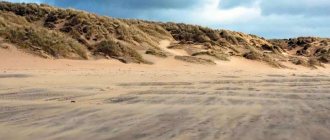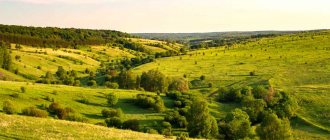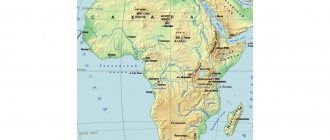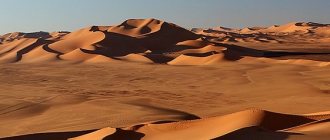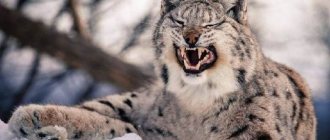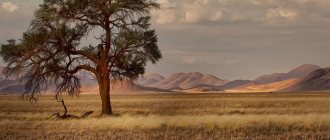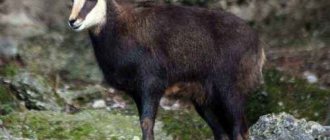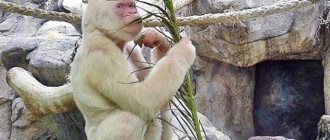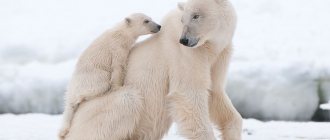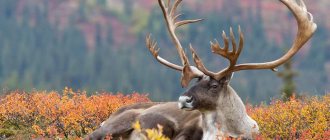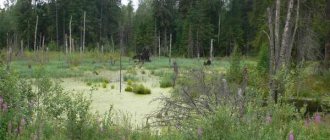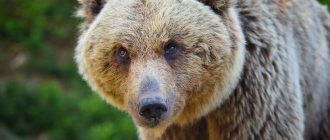Climate Features
The forest zone gradually, through the forest-steppe, turns into a treeless natural zone - the steppe. It looks like a huge field on which fragrant herbs grow.
The steppe zone is located in the temperate climate zone. This means that sunny, dry weather reigns here. This area is characterized by dry winds - hot, dry winds that can turn into strong dust storms.
Summer in the steppe is long, dry, with little precipitation. The average temperature is 20-22 degrees Celsius, but can sometimes rise to 40 degrees. Winter is short and relatively warm. Only occasionally does the air temperature drop to -40 degrees.
In spring, the steppe seems to wake up: life-giving showers moisten the soil, and it is covered with a carpet of bright steppe flowers. However, due to sunny weather, rainwater does not have time to penetrate deep into the ground. It flows into the lowlands and quickly evaporates.
Rice. 1. Steppe in spring.
The main wealth of the steppe zone is fertile lands, which are called chernozem. When grasses die, they form a top nutrient layer – humus, which has unique nutritional properties.
Weasel
Weasel belongs to the same order and family. It lives in a wide variety of places, under different conditions, but, unlike the ermine, it prefers more open places in fields and vegetable gardens.
Description of weasel
The smallest of our predators. Body length up to 25 cm, tail - 6-8 cm. The body is elongated, very flexible. Small head, short rounded ears. The legs are short, the paws have very sharp racing claws. Weasel
The fur is colored chestnut-brown in summer, and becomes pure white in winter (in the southern regions of distribution, the fur color does not change in winter). Often settles in the vicinity of humans - in barns, barnyards, straw stacks.
It destroys mouse-like rodents in large numbers, sometimes killing more of them than it can eat. There are usually 5-7 cubs in a litter. The hunting of weasels is completely prohibited everywhere.
Flora of Ukraine
The climate of Ukraine influences the characteristics of the country's forests. Deciduous forests make up 52% of the total forest area of Ukraine, the remaining forest areas are occupied by coniferous forests. The most dense forests are located in the north-west of Ukraine, where pine, oak, birch and other types of trees grow. In the north-central part, where the forest-steppe strip is located, the most common trees are oak, pine and hornbeam. In the steppe southeastern part, oak and pine are the main tree species. Mountain areas are characterized by three different zones: the lower slopes contain mixed forests, pine forests grow above sea level, and alpine meadows are common in the high altitude areas. In the Carpathians, the main tree species include spruce, beech and oak, and in the Crimean mountains, beech and oak are most often found. The coast of the Crimean peninsula is characterized by deciduous and evergreen vegetation.
Fauna of Ukrainian rivers
The ichthyofauna of Ukrainian rivers mainly consists of representatives of the carp family. The European watershed between the Baltic and Black Seas limits the distribution of some fish species. In the rivers of Ukraine passing through the Baltic states, eel and Baltic sturgeon are found. The rivers flowing into the Black Sea contain gobies, kutum, sterlet, sturgeon, Ukrainian lamprey and other species. In the rivers Tisza, Cheremosh and mountain tributaries of the Danube River, Danube salmon, striped ruffe and common chop are found. Mountain streams contain trout and grayling.
Didn't find what you were looking for? Use the site search form
Did you like the article? Leave a comment and share with your friends
Forest-steppe and steppe
The steppes are connected with the forest zone by an intermediate strip of forest-steppe, the northern border of which coincides with the July isotherm of +20°C.
The forest-steppe is characterized by variegated soils and a combination of interfluve forest landscapes with steppe ones. The forest vegetation of the European forest-steppe is dominated by oak forests with an admixture of linden, ash, maple (in the west - hornbeam, beech), in Western Siberia, where the climate is more continental, birch groves (kolkas) with an admixture of pine and larch. (There is no spruce in the forest-steppe zone.) Gray forest soils develop in forests, and chernozems develop in mixed-grass steppes.
The fauna of the forest-steppe also forms a mixture of forest and steppe species. In forest areas there are pine marten, squirrel, dormouse: occasionally elk and roe deer are found, and in the steppe areas - gophers, jerboa - ground hare, marmot, steppe polecat, and occasionally - bustard and little bustard. In the rivers there are river beaver and muskrat.
Currently, the main areas of the forest-steppe are plowed and turned into agricultural land, where grain crops, beets, sunflowers, potatoes, hemp, corn, and grapes are grown (in the west). In addition to field cultivation, horticulture and vegetable gardening are developed in these areas.
To the south of the forest-steppe zone there is a strip of steppes, which are vast treeless expanses with less pronounced relief dissection than in the forest-steppe. Since in the steppes there is not enough moisture in the soil for the development of woody vegetation, the surface of this zone is covered mainly with grasses, and small groves and thickets of bushes are found only near rivers, and here and there in ravines where the groundwater level is quite high.
The steppe occupies the territory from the lower reaches of the Danube and Prut to the Southern Urals in the latitudinal direction and from the southern border of the forest-steppe to the shores of the Black and Azov Seas, the foothills of the Greater Caucasus and the Crimean Mountains in the meridional direction. Steppes are also common in Western Siberia and Kazakhstan.
The climate of the steppes is continental, especially in the eastern part. Summer is longer and hotter than in the forest-steppe and forest zones. The average temperature in July is +22 ... +23.5°C (the heat in some places reaches +40°C). Relative humidity in summer occurs; about 40-50%. The weather is dry and sunny. Rains usually have a torrential character, as a result of which rapid streams of water flowing into the lowlands do not have time to seep into the soil and quickly evaporate. Frequent dry winds (especially in the east) lead to prolonged drought and drying up of local rivers. Strong winds carry a lot of dust. Winter is shorter and warmer than in the forest zone, but quite cold, with frosts of -20... -30°C. Thin snow cover lies in the Black Sea region for 1-2 months, and in the Volga region for 4-5 months. In the east of the country, winter is more severe, accompanied by freezing of local rivers; in the west there are frequent thaws and sometimes icy conditions. In spring, the rivers experience high floods; in summer and autumn after rains there are floods. The rapid melting of snow entails soil erosion and the formation of ravines, which gradually grow due to storm flows in the summer. The amount of precipitation per year in the western part of the steppe does not exceed 400-500 mm, and in the southeast it decreases to 300 mm.
1next ›last »
Marine fauna of Ukraine
The steppe northern part of the Black and Azov Seas belongs to the coastal region in which waterfowl and aquatic animals are unique. Many species of birds live here: herring gull, tern, sea plover, avocet and spoonbill. The white pelican and the ibis nest at the mouth of the Danube River. Migratory birds stop or winter in this region: wild geese and ducks come here in spring and autumn. Muskrat, European otter, mink, geese, ducks, swans, gadflies, mosquitoes and mosquitoes live in floodplains. A mixture of marine and freshwater fish species is found in the estuaries and deltas. Jellyfish, flounder and other marine life live alongside migratory species.
Dolphins and rare monk seals are found in the Black Sea. The species diversity of fish in the Sea of Azov and the coastal waters of the Black Sea is very similar. However, some local species are found in the Azov Sea: Azov herring, Azov anchovy, Azov perkarina, sausage, flounder, sprat and goby.
This is interesting: Fauna of Chernobyl - characteristics, mutations, photos and videos
Forest-steppe protection
The natural landscapes of the forest-steppe were subject to very strong and long-term anthropogenic impact, mainly due to fertile soils. Most of the forest-steppe is plowed and intensively used for agriculture - the traditional occupation of the indigenous population. In some places you can still find some surviving areas of forest-steppe
Sources
Forests in the European part of the forest-steppe consist of oak, birch, and aspen and occupy small areas. In the Asian part, forests occupy 10% of the entire territory and consist mainly of birch and aspen, often mixed with willow, but oak is completely absent. In the middle tier of forests, hazel, mountain ash, viburnum, buckthorn, elderberry, euonymus, and rose hips often grow, and in the lower tier (in the grass cover) ferns, crow's eye, vetch, kupena, hoofed grass, violet, etc. predominate. In the forest-steppe zone There are a large number of species of herbaceous plants, in this respect it surpasses all other plant zones. The presence of a large number of species, often differing in different rates of development, gives the forest-steppe a colorful appearance. Throughout the growing season, flowering plants are found here, which causes a pronounced change in aspects. In the forest-steppe there are many representatives of various herbs, and among them there are quite a lot of moisture-loving ones (snake knotweed, or crayfish, dog violet, shepherd's mantle, etc.). Among the cereals, rhizomatous and broad-leaved ones predominate; fescue and feather grass are few. The vegetation cover of the forest-steppe is characterized by a continuous cover of tundium moss. Of the ephemerals, only white hyacinth and goose onion are found in the forest-steppe. The herbaceous cover of the forest-steppe of the European part is distinguished by a diversity of species composition; perennials predominate. As you move south, the grass cover changes significantly. Thus, if the meadow vegetation of the forest-steppe within the Central Black Earth zone is represented by such plants as straight brome, horned common grass, creeping wheatgrass, meadow timothy, fescue, meadow rank and others, then to the south steppe timothy, yellow alfalfa, sainfoin, fescue, keleria, wheatgrass, feather grass, etc.
Consequences of a viper bite
Very serious consequences are possible only in rare cases, death is extremely rare and only in case of failure to provide medical care. Bites are especially dangerous for children, the elderly and people with reduced immunity. At the same time, oddly enough, for approximately 30% of people, a viper bite is painless and does no harm, 40% experience acute pain, and a tumor appears at the site of the bite.
How does snake venom work? In severe cases, after 15-30 minutes the following are possible: dizziness, nausea, vomiting, diarrhea, pale skin, increased sweating, chills, tachycardia, loss of consciousness, tissue swelling and inflammation of the lymph nodes.
7) Woolwing
Woolly winged lemurs are sometimes incorrectly called "flying lemurs". These animals are not lemurs and are not capable of flight in the full sense of the word. Like many lemurs, these mammals are perfectly adapted to life in the trees. They appear to have wings, but upon closer inspection, you can see that the “wings” are leather membranes that expand like wings when woolwings jump from one tree to another, thereby allowing them to cover relatively long distances in the air – up to 100-140 meters. It is interesting that these animals practically do not reduce their height while jumping and gliding with the help of their membranes. This is very convenient, since woolly wings do not climb trees very well: they awkwardly move from branch to branch using their paws without thumbs.
Best articles: How to get rid of fleas on an adult cat and kitten at home
Brown bear
In Ukraine, the brown bear is found in the Carpathians, although it can also wander into the forests in the north of the Chernigov and Sumy regions. In total, there are no more than 300 individuals in Ukraine and the animals are still hunted by poachers. Bears are also subjected to other abuses: they are trained in circuses, kept for entertainment in restaurants or private households.
There is a rehabilitation center for brown bears on the territory of the Synevyr National Natural Park. There, the animals are treated, both physically and psychologically - many of the bears, once free, continue to perform circus tricks.
At the center, specialists help bears return to their true nature, and some animals have even learned to spend the winter in dens that they “built” themselves.
Brown bear
Capercaillie
This beauty is one of the largest birds of the Ukrainian Carpathians. Wood grouse are listed in the Red Book of Ukraine, but this does not stop poachers from hunting them.
Also, deforestation, cattle grazing, and even tourism in areas where small chicks are hatching also contribute to the population decline.
Capercaillie
Ermine
The stoat is a small, fluffy and fast animal with beautiful fur that turns brownish-yellowish-gray in summer and white in winter. Ermines have become victims of the fashion industry - their dense and soft fur is still made into fur coats.
In Ukraine, these cute animals are under state protection; they are included in the Red Book of Ukraine, and hunting them is prohibited even for the purpose of research.
Ermine
Black stork
The black stork is not so easy to find in nature because, despite being rare, it leads a secretive lifestyle and tries to avoid people. In total, there are about 400-450 pairs of these birds in Ukraine.
Black storks nest mainly in Polesie and the Carpathian region.
Black stork
Fire salamander
When traveling through the Carpathians, watch your step carefully, because a fire salamander may sneak along the path. They are easily recognized by their unusual coloring - a black body with yellow spots.
Fire salamander
garden dormouse
A small rodent with huge eyes. Garden dormouse is found in forests (coniferous, deciduous and mixed), although it is sometimes found in gardens and vegetable gardens.
garden dormouse
barn owl
Are you afraid of owls, their huge eyes and creepy screams? If so, then in vain. Owls, in particular, regulate the number of rodents that harm farms.
One of the types of owls that are found in Ukraine is the barn owl. The rare bird nests in the western and central regions of Ukraine, as well as in the north of the Odessa region. There are fewer and fewer barn owls in the world: throughout Europe there are 110-220 thousand pairs, and in Ukraine there are about 30 pairs.
barn owl
Lynx
Lynx has also become a victim of the fashion industry. These perfect and graceful animals were hunted for their fur for a long time. Now these predatory cats are rare in Ukraine: in the Carpathians there are about 350-400 individuals, and in Polesie - up to 80-90.
Lynx
Leopard snake
This is a very beautiful and equally rare non-venomous snake, which has the status of an endangered species.
If you are lucky enough to meet this reptile, it will only be in Crimean nature reserves, and not every year.
By the end of the 40s of the 20th century, the leopard snake was still a common species, and since the 70s the snake was seen every few years. Now the leopard snake is actively hunted by snake lovers for personal collections and for sale.
Leopard snake
According to the Red Book of Ukraine
Lure for Ukraine
Some Asian and African countries still practice a simple trick to catch monkeys. This requires only a heavy vessel with a narrow neck into which grains, nuts or fruits are placed. Overwhelmed by curiosity, the animal sticks its limb inside the jug and, having grabbed as much of the treat as possible, is no longer able to free itself - the opening is too narrow for the fist with the bait. Even the appearance of a hunter does not always force the monkey to abandon its prey.
What is behind the loss of the instinct of self-preservation, the only important thing in nature - lack of intelligence or greed, does not matter. The animal pays for its mistake with freedom, and in the worst case scenario, with life.
This scheme has found its application in the modern world, where the function of profit is performed by money, and the role of poor animals is assigned to economically poor countries, the list of which includes Ukraine.
Today this state is closer than ever to economic collapse and total enslavement. And these are not the machinations of the “Russian aggressor.” In many ways, this state of affairs is due to the pro-Western vector of Kyiv. The final line was drawn a few years ago by ex-President of Ukraine Petro Poroshenko, when in an interview he called a Russian loan of $3 billion a “bribe” received by his predecessor Viktor Yanukovych.
Since then, the “bribes” from Russia have stopped, and Ukraine has finally become hooked on the financial needle of international organizations. However, the period of verbal exchanges of pleasantries with the West is far in the past. It has been replaced by an era of action and fulfillment of specific demands. As it turned out, not all of the conditions put forward by foreign partners were to the liking of current Ukrainian politicians, and the population in particular.
Another alarm bell was the new loan program with the International Monetary Fund, IMF, or IMF. This organization is one of the “hunters” of third world countries. The geography of IMF's financial hostages is very extensive: from African states and Latin American countries to Mexico, Yugoslavia, and finally Greece and Iceland. Not every debtor managed to escape from the traps set.
Mammals
Narrow-nosed monkeys
Broad-nosed monkeys
The tropical forests are home to predators such as leopards and pumas.
Leopard
Puma
An interesting species is the American tapir, somewhat reminiscent of a horse and a rhinoceros.
Tapir
Nutria can be found in ponds. People hunt this type of large rodent because they have valuable fur.
Nutria
In the South American rainforests you can find sloths that resemble monkeys in appearance. They have fairly long and flexible limbs with which they cling to trees. These are slow animals; they move slowly along the branches.
Sloth
Armadillos, which have a powerful shell, live in the forests. During the day they sleep in their burrows, and at nightfall they come to the surface and lead a nocturnal lifestyle.
Armadillo
An inhabitant of tropical forests is the anteater. It moves without problems on the ground, climbs trees, eats ants and various insects.
Ant-eater
Among the marsupial species, opossums can be found here.
Opossums
African rainforests are home to elephants and okapi, which are related to giraffes.
Elephant
Okapi
Giraffe
Lemurs, which are considered prosimians, live in Madagascar.
Lemurs
Some reservoirs are home to crocodiles, among which the Nile crocodile is the most famous. In Asia, long-snouted crocodiles are known, which mainly swim in the Ganges. The length of its body reaches 7 meters.
Nile crocodile
Rhinoceroses are found in tropical forests, and hippos are found in ponds.
Rhinoceros
Hippopotamus
In Asia you can find the tiger, sloth bear and Malayan bear.
Malayan bear
Sloth bear
Classification of animals by natural zones
Animals of Ukraine are a fairly large group. Their distribution depends on the natural zone in which they are distributed. So, what animals of Ukraine live in different places of this country?
- In Polesie you can most often find wild boars, pine martens, wolves, roe deer and foxes. Previously, even brown bears lived here, but now their range has shifted to the most remote areas. Beavers, otters and minks are valuable fur resources. These animals can also be found in Polesie. Dangerous snakes such as vipers are found in this natural area along with fast lizards and pond frogs.
- In the forest-steppe region - where forest and steppe species of animals coexist. These include field mice, voles, dormice and roe deer, as well as ferrets, hamsters and mole rats.
- In the steppes, the most common species found are rodents, such as jerboas and ground squirrels, as well as the elk. Birds that typically inhabit steppe zones are quite rare in the Ukrainian steppes. These include the bustard, crane, stone eagle, and little bustard.
- Representatives of the fauna such as the mountain ferret and snow vole live and breed in the Carpathians. Lynx, hazel grouse, black grouse and wood grouse are found in the mountain forest zone. Roe deer, martens, squirrels, wild boars, hawks, golden eagles and foxes - all these animals live in any area of the Carpathian Mountains. Even the rarest wild cat lives here.
Record-breaking animals
There are a huge number of living organisms on the planet that are superior to others according to some data. For example, some run fast, while others jump high. Ukraine also has record holders who are known throughout the world.
The largest animal in this country is the bison. Its mass can reach a whole ton and even exceed it. By the way, the animals of Ukraine are also record holders in terms of height. And this is a bison again, because at the withers its height reaches two or even three meters. But the moose has the richest antlers. Their span is one and a half meters. It is slightly smaller for the red deer - one meter.
The largest marine resident is the Black Sea bottlenose dolphin. The body length of this animal reaches three meters. The small shrew is a tiny creature. Together with the tail, it can fit on a ruler six centimeters long. A scale, the maximum value of which reaches 10 grams, is enough to measure her body weight.
The fastest hare in Ukraine is a hare that can run at a speed of 70 kilometers per hour. The long-liver is a beaver. The lifespan of these animals in the wild is almost 50 years. Among domestic animals, donkeys live the longest.
The bottlenose dolphin's daily diet includes 30 kilograms of meat, while the shrew needs only 10 grams of this product per day.
A breed of cats with big ears. Oriental breed, where to buy?
Where can you buy a healthy kitten without being scammed? There are several rules that must be followed:
- Purchase from a trusted seller. It is better if it is an experienced breeder.
- A conscientious seller does not give away kittens earlier than three months of age, since all vaccinations must be completed first. Otherwise, there are risks of buying a sick baby or one with a weakened immune system susceptible to infections.
- Look at the conditions in which kittens and their parents live. The room should be clean and there should not be a large concentration of animals.
- Conclude a purchase and sale agreement.
- The kitten must have documents confirming its breed and a passport with vaccination records.
- Remember that a healthy, vaccinated, well-groomed, purebred kitten simply cannot be cheap.
Quantity
History of the Red Book of Ukraine
The Ukrainian Red Book is an official document. On its pages you can find materials about all animals and plants that are on the verge of extinction, and are also very rare and almost never found in the wild. Working with this document, scientists develop measures used to preserve populations of many organisms.
What is the history of the Red Book? Some plants and animals of Ukraine first came to it in 1980. Then the document was published in one volume. However, fourteen years later, the Red Book appeared in two parts. One of them was dedicated to the animal world, and the other to the plant world. The circulation of both volumes was about seven and a half thousand copies.
Best articles: What organisms live in the depths of the Mariana Trench?The most recent edition, which was published in 2009, included almost 550 species of animals, 542 to be exact, and 826 species of fungi and plants.
Symbols of Ukraine
It is known that almost every state has its own symbols. Very often these are some kind of animal or plant. In Russia it is a bear, and in France, for example, it is a rooster. Most often, the appearance of an animal symbol in any country is due to the fact that this creature is often mentioned in folk tales, fairy tales and legends.
Ukraine does not have an animal symbol. Even after the popular election of an animal mascot, the country's residents did not come to a consensus. The fact is that theoretically the symbol of this state could be a horse or aurochs, a cuckoo or a crane, a stork or a nightingale, a swallow or a whist.
All these animal symbols of Ukraine are found in the works of folklore of this country. However, with the same success, wolves and bears, chickens and hares are mentioned in fairy tales and songs composed by Ukrainians. One state cannot have several animal symbols. Moreover, not all of the named representatives are generally recognized, and this is a prerequisite when choosing a symbol of the country.
The best option is the Rurikovich falcon. Since ancient times, it has been depicted on the state coat of arms in a schematic form. Currently, he has transformed into a trident.
Vertebrates
Mammals
Main article: List of mammals of Ukraine
Mammals of Ukraine are classified into the following orders:
- Soriciformes - order Insectivorous (14 species)
- Vespertilioniformes - order Chiroptera (26 species)
- Caniformes - order Carnivorous (22 species)
- Leporiformes - order Lagomorphs (3 species)
- Muriformes - order Rodents (52 species)
- Equiformes - order Equiformes (2 species)
- Cerviformes - order Artiodactyls (9 species)
- Delphiniformes - order Cetaceans (4 species)
Thus, the number of mammals includes: 14 insectivores, 26 bats, 22 carnivores, 55 rodents, 15 ungulates. In total, this amounts to 154 species, 8 genera, 31 families.
Birds
Main article: List of birds of Ukraine
Southern Nightingale
According to various estimates, the avifauna of Ukraine includes 423 or 424 or 425 species, of which 12 are introduced. Among them are 267–270 nesting species, of which 132–138 species are wintering; 17 species appear only during wintering, 129 species are observed only during seasonal migrations or have the status of vagrants. For example, the migration of Swainson's thrush was recorded only once on November 10, 1893 near Kharkov, but it breeds only in North America. Birds found in Ukraine belong to up to 21 systematic series. The range of passerines is the most diverse; there are 172 species. There are also numerous representatives of Charadriiformes - 79 species, Anseriformes - 38 species, Falconiformes - 35 species.
Fish
Numerous Ukrainian reservoirs are home to: Danube herring, horse mackerel, bream, crucian carp, fisherman, common catfish, pike, marsh turtle, mute swan, great egret, long-billed, great and small cormorants, pelican, greylag goose, river duck , otter, beaver and other species. Mollusks, crustaceans, and zooplankton live in rivers, lakes and reservoirs.
There are more than 2,400 species of animals in the Black and Azov Seas. The fauna of the Azov and Black Seas has much in common, since they are connected by the Kerch Strait, which provides periodic migration of many species of fish. But there are also specific local species, for example, in the Azov Sea there are Kerch herring, belly, anchovy, flounder, sprat and goby, and in the Black Sea - sturgeon, beluga, sturgeon, mackerel, horse mackerel, mullet, Black Sea salmon, Dnieper and Danube herring, sea Horse. Mammals include the white-bellied seal and two species of dolphins – the white-sided dolphin and the bottlenose dolphin.
Reptiles
Main article: List of reptiles of Ukraine
In total, 25-26 species have been recorded on the territory of Ukraine. Of these, 2 are introduced (Dahl's lizard and Armenian lizard), 2 are invasive (Turkestan gecko and wall lizard), the invasion of another species (red-eared turtle) has not been fully confirmed, and the introduction of another species (Adjarian lizard) was not successful. The fauna of reptiles (herpetofauna) is dominated by reptile species of the Mediterranean-Central Asian type (for example, yellowbell, water snake, steppe viper, etc.), 7 species (Crimean gecko, green and Crimean lizards, Lindholm's lizard, Aesculapian snake, Sarmatian and Caspian snake) - belong to the fauna of Southern Europe and the Mediterranean. Two species (spindle and copperhead) are common in Central and Southern Europe. Species with wide ranges include 5 representatives of the herpetofauna of Ukraine, in particular the marsh turtle, snapping and viviparous lizards, the common snake and the common viper, and narrow-range species include the Lindholm's lizard and Nikolsky's viper. Considering the heat-loving nature of reptiles, it is in the southern part of the country that almost all of their species are found. Above the border of the steppe zone, only 12 species of reptiles have been recorded. The herpetofauna of the northern regions differs significantly from the fauna of the southern regions due to the presence of forest species of reptiles, including the viviparous lizard and the common viper, which are not found further south. On the contrary, a number of Mediterranean and Asian species appear in southern Ukraine. In general, reptiles gravitate towards relatively open and warm areas. Therefore, the least species diversity is observed in the zone of mixed and broad-leaved forests, and the greatest - in the steppe and forest-steppe.
Reptiles, snakes and insects
Common copperhead
Steppe viper
Patterned runner
Green lizard
Stag beetle
Yellow-bellied toad
Forests
The forest is a special ecological system, the main component of which is the tree. A third of the landmass of our planet is covered by forests. They are adapted to cold and hot climates.
temperate zone
They occupy most of Europe, Asia and North America, as well as small areas of South America and New Zealand. The seasons are clearly defined: cold winters and moderate summers with plenty of rainfall. Their number depends on the location of the forests. In some latitudes, precipitation falls evenly throughout the year. This belt is represented by coniferous and deciduous trees.
Broadleaf
They grow in temperate climates with mild winters and high humidity in summer. They are located in the Far East, Japan, East China, and North America. These are mainly maples, oak and linden groves. To the south, rowan and bird cherry trees appear.
Small-leaved
These trees include birch, aspen and alder. Their feature is the narrow shape of the leaves. They grow in the East European Plain, the Far East and Western Siberia. Small-leaved plants are resistant to temperature changes and grow rapidly.
Conifers
In the area where coniferous trees grow, winters are usually cold and summers are not hot. Fir and spruce trees are often found here, growing up to 30-40 meters in height. They are intertwined with roots, thanks to which they stay firmly in the soil, because do not tolerate strong winds well. The trees are up to 500 years old.
Pines and cedars occupy most of the coniferous forests. These trees love the sun, but tolerate frost and drought well. They grow up to 400-500 years.
Also in coniferous plantations there is larch, shedding its needles. It tolerates cold northern climates and hot steppe climates well. This tree can grow high in the mountains. Precipitation here ranges from 300 to 1000 mm per year.
Mixed
Mixed forests are usually represented by three tiers. The upper tier includes birch, oak, maple, linden, aspen, pine, spruce. The middle tier is represented by bushes of elderberry, hazel, buckthorn, and raspberry. The lower one contains ferns, wild berries, mushrooms and mosses. There are long, cold winters and warm, long summers and sufficient humidity: 700 mm of precipitation per year.
Subtropical zone
Gemigilea
A special zone with a subtropical climate, where evergreen oaks, magnolias and laurels grow. The trees are intertwined with numerous vines, and the thickets of bushes and bamboo add significant diversity.
Monsoon mixed
Temperature changes here are almost imperceptible. Thanks to this, vegetation develops rapidly. Pines, firs and evergreen oaks grow here. Magnolias, camellias and palms also feel great.
Stiffleaf
In the Mediterranean regions, hard-leaved forests grow. The climate in this area is dry, summers are hot and dry. Winter without frosts, but with precipitation of 500-1000 mm per year. Single-tiered forests with a wide crown. The undergrowth is dense with evergreen shrubs. Trees with thick bark branch from the very ground. The leaves of the trees are adapted to arid climates. They are tough and resistant to fading. Noble laurel, olives, roses, and myrtle grow here.
tropical zone
Seasonal
This zone is in areas with dry periods and good humidity during the rainy season. The amount of precipitation per year can reach up to 3000 mm. Deciduous seasonal forests are represented by monsoon and savanna forests. Eucalyptus, baobab, acacia and palm trees grow here.
Wet
They are characterized by large amounts of precipitation - up to 10,000 mm. It rains almost every day. The temperature remains virtually unchanged throughout the year and is around +27°C. It has the greatest variety of plant species. The following trees grow in humid areas: sandalwood, chocolate tree, woolen tree and redwood tree. The height of many reaches 50 m. Many trees are entwined with vines.
Dry
This species is found in many places where the rainy season is abruptly followed by a dry season lasting several months. During the year, 1000-2000 mm of precipitation falls. The climate is warm, the average temperature is +25-30°C. Deciduous species predominate here: teak and ebony. During periods of drought, they avoid death by falling leaves.
Steppe
To the south of the two seas (Black, Azov) and the forest-steppe zone there is a steppe territory. Its surface is mostly flat, with ravines, ravines, and hills. The sun rises higher here, so this natural zone of Ukraine (steppe) has a hotter climate. Summer here is longer and much warmer. There is less precipitation. Autumn is warm, the first half is dry, the second half is rainy. Winters have little snow, are short and cold. Due to sudden increases in temperature, the moisture that the soil absorbs quickly evaporates. Frequent dry winds precede droughts. Cold winter winds cause blizzards and storms. They destroy fertile soil.
Best articles: Lightning among dogs - small English greyhound whippet
Large rivers flow through the steppes. The Danube Delta is rich in fresh lakes, and the Black Sea coast is rich in salty estuaries. Several reservoirs (cascades) were built on the Dnieper.
The plants here are predominantly herbaceous. Bushes and trees are found in ravines and near the shores of reservoirs - only there they have enough moisture.
In early spring the steppe is bright and colorful. There is still enough moisture in the soil at this time, and many plants feel very comfortable. There are hyacinths, irises, adonis, crocuses, poppies, tulips, and peonies. Plant seeds are given before the peak of heat. Some “drop” the ground part (it dies). The roots continue to accumulate moisture and nutrients: next year they will sprout and bloom again.
Soon more hardy, unpretentious plants appear: fescue, wormwood, feather grass. Some have pubescent, narrow leaves, while others have long roots that allow them to withstand heat and lack of water. By mid-summer the plants begin to dry out. The wind, picking them up and rolling them across the steppe, shakes out the seeds. This natural zone of Ukraine seems gray and inhospitable at the end of summer. The fauna here is poorer than in the forest. Many animals have a characteristic light yellow color, which makes them less noticeable among the withered, yellowed grass. Most of them live in minks. These are mainly rodents: mice, jerboas, ground squirrels, marmots, hamsters. Badgers, foxes, and ferrets dig holes. Such dwellings are also the birthplace of offspring, a refuge, and a place for hibernation. Agile lizards, vipers, and steppe turtles live in holes dug by small animals.
Thanks to their ability to move quickly, rare steppe birds, little bustards and bustards, escape from numerous enemies.
In early spring you can hear the lark singing. Quails also give voice. You can see rare steppe cranes. A falcon, an eagle, a kestrel, and a harrier soar in the sky. They prey on smaller birds and mice.
Many insects live in the steppes: grasshoppers, butterflies, locusts, beetles. They feed on various parts of plants, at the same time providing food for amphibians, reptiles, and birds.
For the sake of preserving the nature of this zone, such reserves as the Ukrainian Steppe, Askania-Nova, and Lugansk were created.
Badger
The badger is found throughout Ukraine. Mustelidae family. At the end of the last century, due to intensive fishing, the number of badgers decreased significantly and hunting was completely prohibited. Currently, the badger has been removed from the list of endangered animals, since the number has been restored to a safe level.
Description of the badger
The animal is medium in size, the body is squat, somewhat clumsy. The head is elongated, the legs are short, massive, and the toes have long and sharp claws. Body length up to 90 cm, tail - 15-20 cm. The fur is long and coarse.
Badger
The back and sides are gray or grayish-brown, the head is white, there are longitudinal black stripes on the sides of the head, a brown stripe runs along the ridge, the underside of the body is dark brown or black. A forest dweller, lives in burrows with numerous passages and an extensive network of underground passages.
He is very neat, periodically cleans and updates his home. Leads a nocturnal, extremely hidden lifestyle. It goes into hibernation for the winter. In March - April, the female gives birth to 2-5 cubs.
The most common animals in Ukraine
As mentioned earlier, the animals of Ukraine are a very large group. What species are most common in this country? So there are a lot of predators here. These include representatives of the wolf family, foxes, martens, and lynxes. Other animals of Ukraine are artiodactyls. Their group consists of moose and wild boar, roe deer and mouflon. Wild sheep also have this name. Rodents that are common in this country are ground squirrels, jerboas, hamsters and field mice.
Animals of Ukraine are not only predators and artiodactyls. This country is home to a large number of fish, such as pike, carp, perch, and bream. And the birds common here are owls and partridges, seagulls and black hazel grouse. Thus, the fauna of Ukraine is very diverse, and representatives of many species of the animal world can be found in the country.
The territory of this state is home to a large number of creatures dangerous to humans. Some of them are poisonous, while others are also very small. These include vipers, tarantulas and karakurts, as well as centipedes. Thus, not all animals in Ukraine are “cute” and “fluffy”. Describing them all may take a very long time, so it will not be presented in this article.
However, it is important for people who are going to visit the forests and mountains of Ukraine to study all the dangers that may await them
Some numbers
Ukraine is a country where you can find 28 thousand species of animals. More than six hundred species, or rather 690, are vertebrate creatures. These include mammals, whose number is measured at 100 species, birds (there are 350 species in Ukraine), and reptiles (there are more than 20). Amphibians are only 19 species out of 28 thousand, fish are 90 marine species and 110 freshwater species.
As for insects and protozoa, their group is the most numerous. The class of arachnids is a fairly large group, which includes more than 3,300 species. Other insects account for 20,000 species. There are one and a half thousand protozoa in Ukraine, and seven hundred species of worms.
Flora and fauna
Vegetable world
The flora of Ukraine includes about 30 thousand species of plants, of which over 400 are listed in the Red Book. 19 million hectares (about a third of the territory) are occupied by natural vegetation.
Most endemic, rare and endangered species are found in the Crimean Mountains and the Carpathians, where almost half of all endemic and about 30% of all rare and endangered species are concentrated.
Today, 14% of the territory of Ukraine is occupied by forests. The composition of tree species in forests changes under the influence of human economic activity. Plantings of valuable species (oak, beech) are increasing, and plantings of less valuable species (hornbeam, aspen) are decreasing. About half of Ukraine's total wood supply is made up of coniferous trees - pine, spruce (fir), fir.
The forests of Ukraine are rich in berries, mushrooms, fruits of wild plants, and medicinal plants. Among the valuable plants that are used in medicine, almost 250 species are recognized as medicinal in Ukraine, including 150 by scientific medicine. The regions richest in medicinal plants are the Polesie and forest-steppe regions, as well as the Carpathians.
Animal world
The fauna of Ukraine is distinguished by a diverse species composition and numbers almost 45 thousand species of animals. On the territory of Ukraine there are many unique natural areas where rare relict animals are found.
The forest zone is characterized by elk, roe deer, wild boar, red deer, and squirrel; there are quite a few foxes and wolves. There are brown bears and lynxes. Of the birds, most of them are black grouse, hazel grouse, wood grouse, starlings, tits, blackbirds, and storks. In the steppe zone there are ground squirrels, hamsters, jerboas, field mice, bobcats; Birds include lark, quail, pink starling, and steppe eagle. Some fur-bearing animals (nutria, mink, silver fox, muskrat) were brought from other areas, and they acclimatized well.
Very diverse fauna on the Azov-Black Sea coast in river deltas. There are especially many birds - ducks, herons, pelicans, gulls, cormorants. Sturgeon, mackerel, horse mackerel, mullet, herring, and gobies are found in the Black and Azov Seas. In rivers, lakes and artificial reservoirs there are perch, bream, pike perch, pike, crucian carp, carp, and in Carpathian rivers there is trout.
On the southern coast of Crimea and the mountainous part of the peninsula, where climatic conditions are close to the Mediterranean, animals such as Crimean and rock lizards, leopard snake, southern nightingale, black vulture, red deer, and mouflon are common.
Game animals are also common on the territory of Ukraine - ungulates, fur-bearing animals, as well as game birds. In protected hunting grounds, which exist in almost all regions of Ukraine, hunting for elk, deer, wild boar, hare, fox, wild geese, ducks, etc. is organized.
In Ukraine, 11 national natural parks, 4 biosphere reserves, 16 nature reserves, numerous arboretums have been created, and there are many monuments of landscape gardening art. The most famous are Askania-Nova (Kherson region, late 19th century), Shatsky National Natural Park (Volyn region), dendrological parks - “Sofievka” (Cherkassy region), “Alexandria” (Kiev region), Trostyanetsky Arboretum (Chernihiv region) , as well as natural monuments - Dovbush Rocks in the Ivano-Frankivsk and Lviv regions, Stone Graves in the Donetsk and Zaporozhye regions, the Grand Canyon in Crimea.
Birds of Polesie
Birds typical for Polesie and the Carpathians are the wood grouse, black stork, and hazel grouse, for the Carpathians - the golden eagle, for the southeastern part of Ukraine - the bustard, and the southern part - the snipe.
In the coastal areas of the Black and Azov Seas, the following are common:
- grey goose;
- mute swan.
Many birds in Ukraine need protection. These are the gray crane and the steppe crane, the black-headed gull, the white-tailed eagle, the vulture, the black vulture, the steppe eagle, the golden eagle, etc.
Ukraine is an important region for seasonal bird migrations. The migration route of numerous species of waterfowl and wading birds runs through its territory: they leave the territory of Ukraine in the fall and arrive here in the spring (cranes, storks, cuckoos). Migratory birds live here during autumn and spring migrations (waders, loons, etc.). The coast of the Black and Azov Seas is a wintering place for seagulls, swans, geese, and ducks. Certain species of birds (white goose, white owl, flamingo, etc.). Only occasionally they fly to Ukraine.
This is interesting: Koala
Reserves
The fertile lands of the steppe fields have long attracted farmers. Widespread plowing and grazing have led to the fact that there are very few untouched areas of the steppe left.
To protect the flora and fauna of this unique ecosystem, several reserves were created:
- "Orenburgsky". The very first reserve created in Russia was founded in 1989. A dry steppe area bordering semi-deserts with an area of more than 21,000 hectares. Many rare species of plants and animals are protected here, including the steppe eagle, bustard, golden eagle, and common beaver.
- "Black Lands". Created in 1990. Rare plant species are protected: Taliev's cornflower and Schrenk's tulip. It is also home to saigas, long-eared hedgehogs, jerboas and steppe birds such as the bustard, lark and buzzard.
- "Belogorye". Created in 1999, this reserve is located in the forest-steppe zone, in the southern part of the Central Russian Upland. Several dozen species of animals and over three hundred plants are protected here.
- "Volga forest-steppe". Another reserve, under the protection of which are both steppes and individual forest areas. Rare species of flora grow in it, many of which are included in the Red Book: four species of feather grass, leafless iris, Neottiantha capulata, and Russian hazel grouse.
Thanks to nature reserves and national parks, it is possible to preserve many areas of steppes and forest-steppes in their original form. These territories have become home to many animals and plants that are found only in the steppe zone.
Animals of the Ukrainian Carpathians
The Carpathian Mountains are characterized, as a rule, by forest fauna. The vertical distribution of animals is largely related to vegetation and altitudinal zonation. The subalpine and alpine zones of the Carpathians are inhabited by high-mountain species - snow vole, alpine shrew, mountain ferret, alpine accentor and some insects. Certain taiga species of fauna are found in the mountain forest zone: lynx, wood grouse, hazel grouse, black grouse and others. But most of the fauna consists of Central European forest species that are found in all regions of the Carpathians: rare wild cat, brown bear and roe deer, pine marten, ermine, Carpathian squirrel, wild boar, wolf, fox, golden eagle, hawk, owl, woodcock and others . There are many species of reptiles and amphibians (Carpathian newt, spotted salamander, smooth snake, etc.) and many European mountain species of insects, molluscs and other invertebrates.
